2025开始准备蓝桥杯,很多刷题笔记直接写在了代码的注释里,但是一个一个文件保存在电脑里太麻烦了,所以将所有我自己已经编译通过的代码放在这个文档里,也当是对自己学习成果的一个记录。
我的代码就是按照我自己的思路写的,非常简单也方便我自己理解。 如果能够帮助到和我一样没有什么天赋的朋友,当然是更加荣幸之至。
从函数章节开始
第一题:距离函数

思路
这道题非常简单,直接封装一个函数,用于算每个边的长度。我把这个函数命名为dis。需要注意的是每个输入参数都是double类型,得到的距离distance也是double类型。第二步,在main函数里调用三次这个函数。
代码
#include<iostream>
#include<iomanip>
#include<cmath>
using namespace std;
double dis(double x1, double y1,double x2,double y2)
{
double distance;
distance = pow((pow(x2 - x1, 2) + pow(y2 - y1, 2)), 0.5);
return distance;
}
int main()
{
double x1, y1;
double x2, y2;
double x3, y3;
cin >> x1 >> y1 ;
cin >> x2 >> y2;
cin >> x3 >> y3;
double Cir;
Cir = dis(x1, y1,x2,y2) + dis(x2, y2,x3,y3) + dis(x3, y3,x1,y1);
cout <<fixed<< setprecision(2)<<Cir<< endl;
}
(新学了一个,sqrt()为平方根函数,可以代替上面的pow(,0.5)哈。)
第二题:质数筛
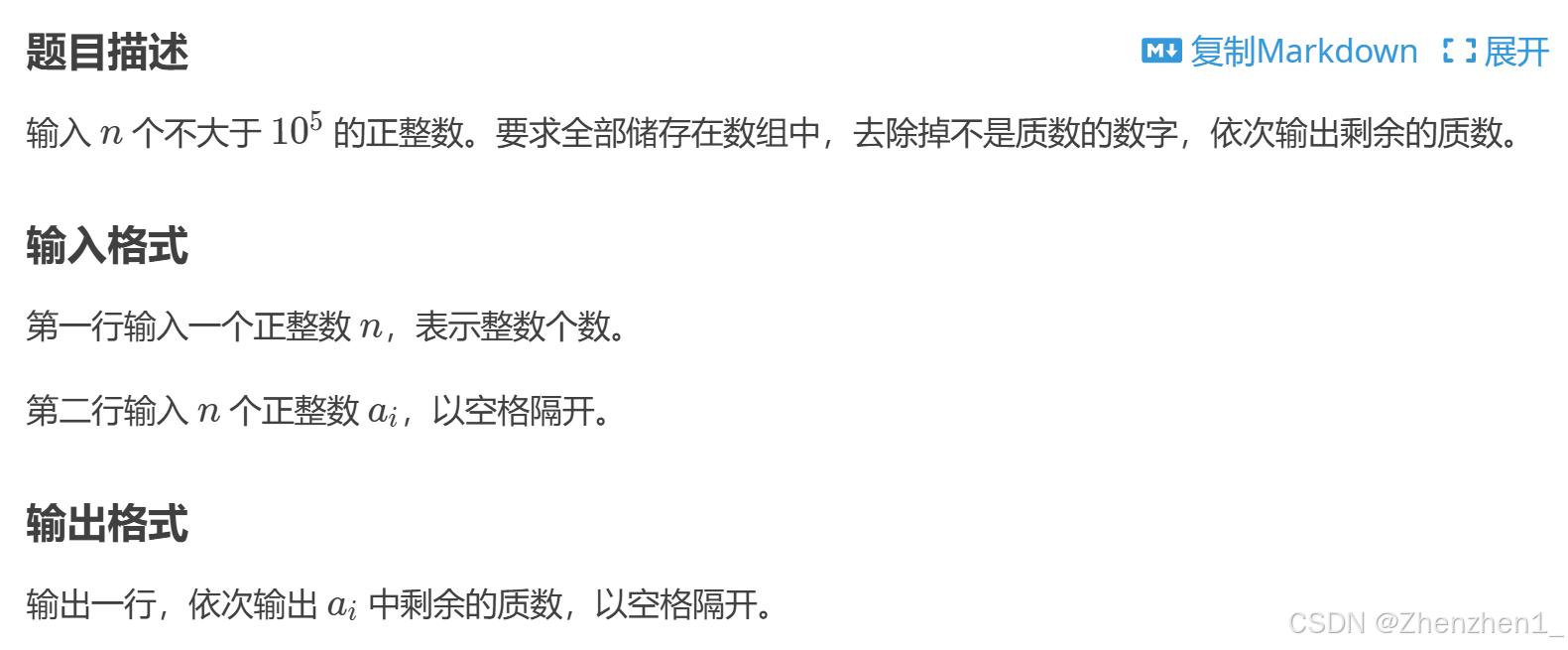
思路
同样,由于是函数专题,我会封装一个函数isPrime来判断是否为质数,为质数的条件是除了1和本身以外没有因数。所以需要遍历从3到就可以了(1,2是特殊的质数,同时因为因数的成对性,只需要判断到该数的平方根即可)。
代码
#include<iostream>
#include<vector>
#include<cmath>
using namespace std;
//判断是否为质数的函数
bool isPrime(int num)
{
if (num <= 1)return false;
if (num == 2)return true;
if (num >= 3&&sqrt(num)>=3)
{
for (int i = 2; i <= sqrt(num); i++)
{
if (num % i == 0)return false;
}
return true;
}
if(num>=3&&sqrt(num)<3)
{
for(int i=2;i<num;i++)
{
if (num % i == 0)return false;
}
return true;
}
}
int main()
{
int n;
cin >> n;
vector<int> numbers(n);//用vector来动态分配number数组,避免n是一个变量引起的程序错误
for (int i = 0; i < n; ++i) {
cin >> numbers[i];
}
vector<int> primeNumbers;
for (int num : numbers) {//这里的for循环为了遍历numbers容器里的所有元素
if (isPrime(num)) {
primeNumbers.push_back(num);
}
}
for (int prime : primeNumbers) {
cout << prime << " ";
}
return 0;
}
第三题:闰年展示
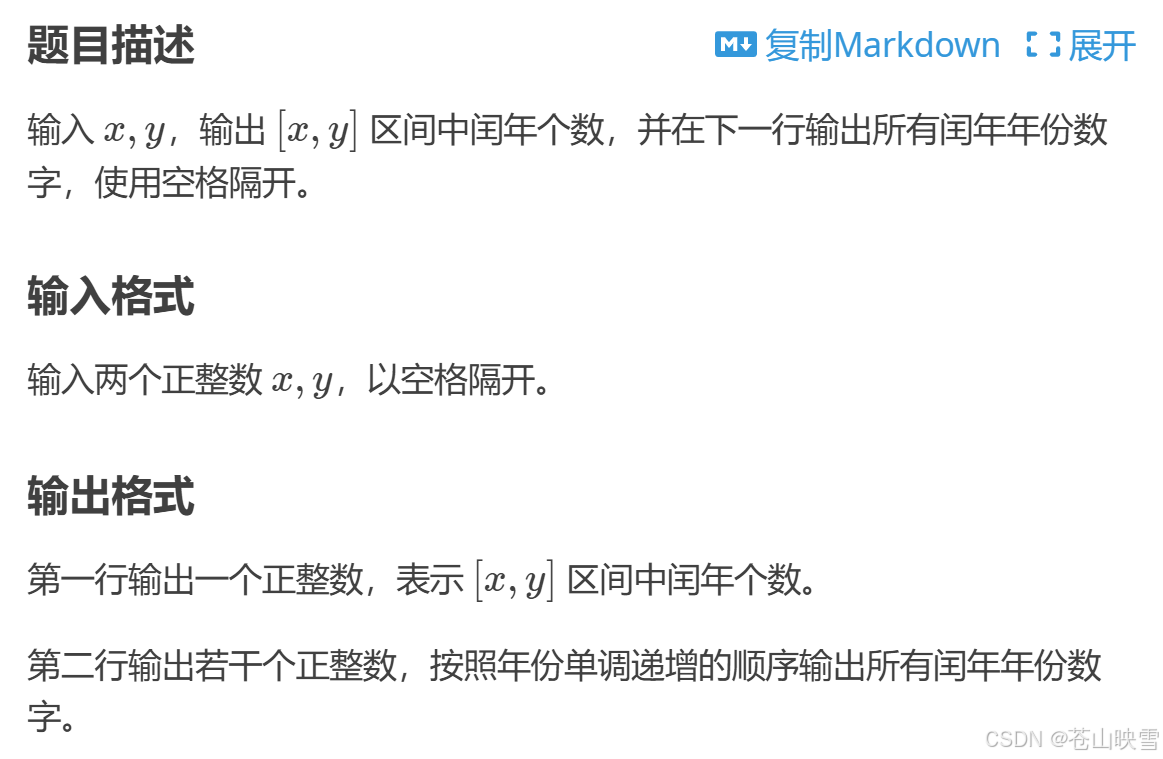
思路
这道题其实跟上一道题思路一致。先判断是否是闰年:除以4的余数是否为0,同时如果是世纪年的话,必须要被400整除(第一遍我没有考虑这个条件,相信也有很多小伙伴会忽略);然后将是闰年的数字输出出来。难点是这道题输入的两个数字是年份范围,所以我认为如何处理这个年份范围是关键。
代码
#include<iostream>
using namespace std;
bool isYear(int x)
{
if (x % 4 == 0 && x % 100 != 0)return true;
else if (x % 400 == 0)return true;
else return false;
}
int main()
{
int x, y;
int account=0;
cin >> x>>y;
for (int i = x; i <= y; i++)
{
if (isYear(i))
{
account++;
}
}
cout << account << endl;
for (int i = x; i <= y; i++)
{
if (isYear(i))
{
cout << i << " ";
}
}
}
第四题:歌唱比赛
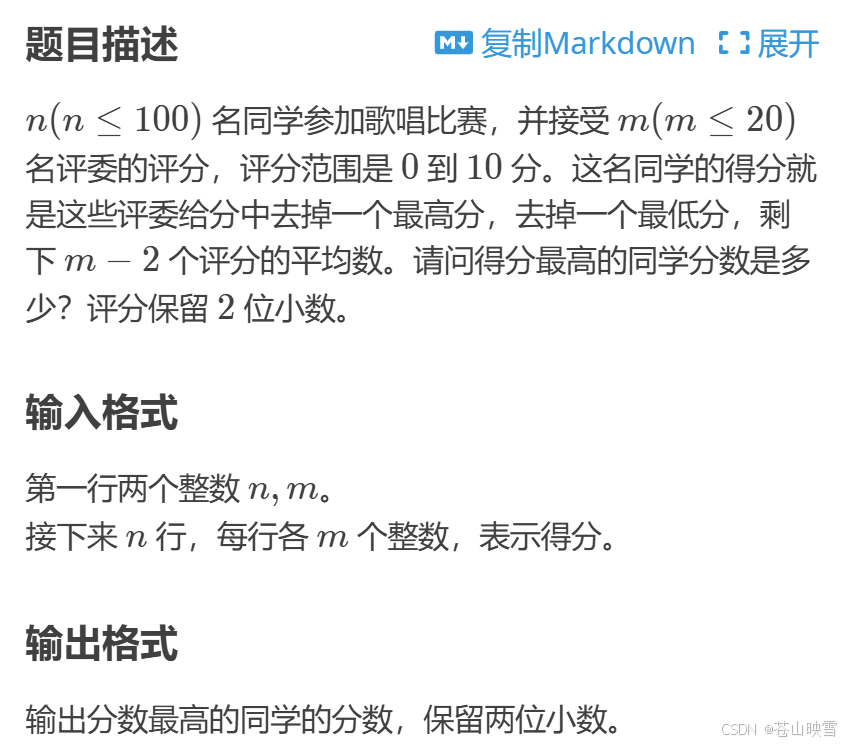
思路
需要记录有n名同学参加比赛和有m名评委,如果将这 n*m个数看作是一个n*m的矩阵(也就是二维数组)然后再用一个n行向量存储平均分后输出最大的就很简单了。
代码
#include <iostream>
#include <vector>
#include <algorithm>//排序sort的头文件
#include <iomanip>
using namespace std;
double calculateScore(vector<int>& scores) {
// 去掉一个最高分和一个最低分
sort(scores.begin(), scores.end());//排序函数,两个参数first和last,表示需要排序范围的开头和结尾
scores.erase(scores.begin()); // 去掉最低分,erase函数就是删除函数,里面的参数为需要删除的数字
scores.pop_back(); // 去掉最高分,pop_back是删除最后一个元素的函数
// 计算剩下评分的平均值
double sum = 0;
for (int score : scores) {
sum += score;
}
return sum / scores.size();
}
int main() {
int n, m;
cin >> n >> m;
double maxScore = 0.0;
for (int i = 0; i < n; ++i) {
vector<int> scores(m);
for (int j = 0; j < m; ++j) {
cin >> scores[j];
}
double score = calculateScore(scores);
if (score > maxScore) {
maxScore = score;
}
}
// 输出最高得分,保留两位小数
cout << fixed << setprecision(2) << maxScore << endl;
return 0;
}
第五题:计算阶乘
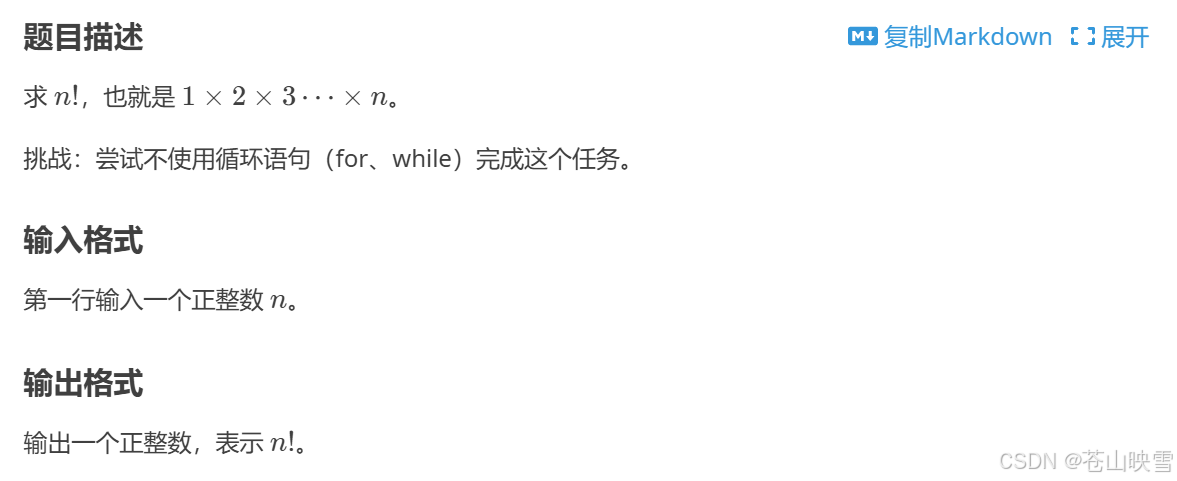
思路
这个题如果用for和while循环就是非常基础的题型,这里就直接尝试不用循环结构。如果不用循环结构,即可以马上反应过来,这里应该采用递归算法。
代码
#include<iostream>
using namespace std;
int jieCheng(int a)
{
if (a > 1)
{
return a * jieCheng(a - 1);//采用递归算法
}
else if (a == 1)
{
return 1;
}
}
int main()
{
int n;
cin >> n;
int ans = jieCheng(n);
cout << ans << endl;
}
第六题:赦免战俘
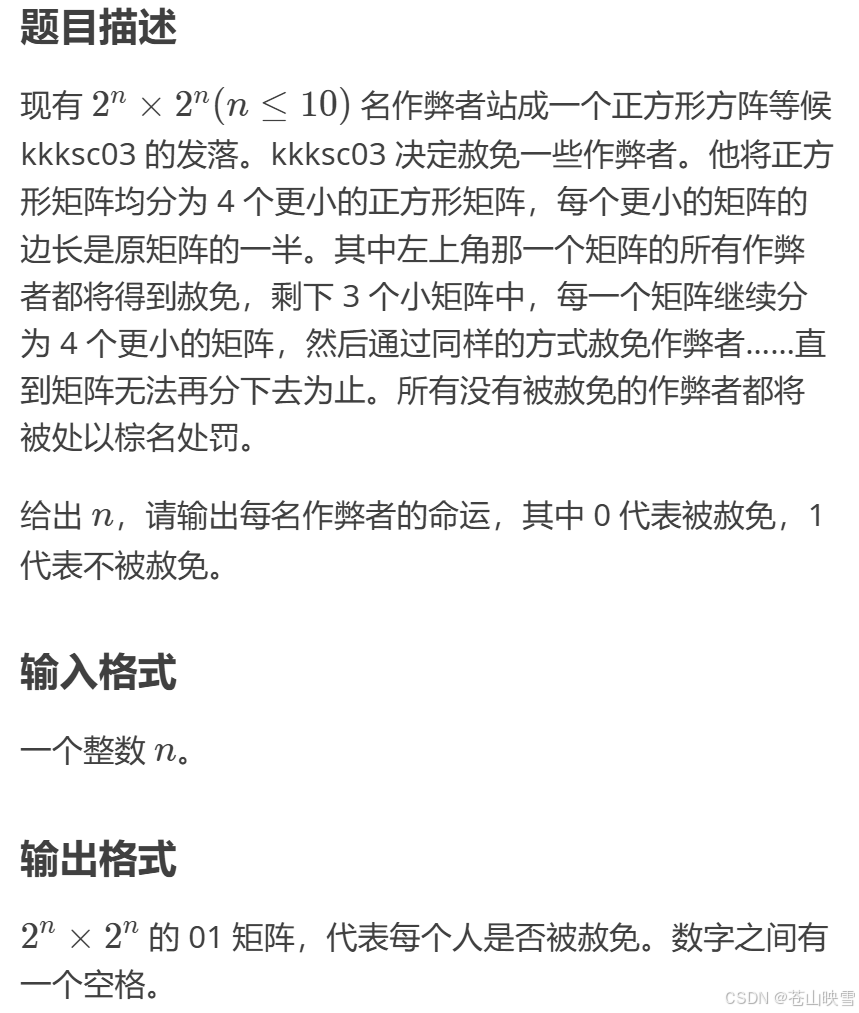
思路:
这个题一看数据量是一个正方形,我的第一思路是用二维数组。所以创建一个大小为的二维数组。第二个问题,应该如何表示左上角的正方形呢?我们知道,数组的编号是从0到n-1的,如果大小为8*8的数组,左上角的正方形就应该是array[0][0]到array[3][3]这组4*4的数据,我在这里考虑直接利用计算机除法向下取整的特点(或者直接用取整函数:floor向下,ceil向上):比如
,但是计算机除法会直接向下取整等于3,刚好是for循环遍历的终点。
结果不是很好,因为如果n很大,这样就没办法表示,所以我决定采用坐标来表示每个正方形左上角的点,并且用递归的方法使每分成4个正方形就直接处理。
代码:
#include <iostream>
#include <vector>
#include <cmath>
using namespace std;
void square(vector<vector<int>>& people, int x, int y, int size)
{
// 递归终止条件:矩阵大小为 1x1
if (size == 1)
{
people[x][y] = 1;
return;
}
// 分成四个小正方形
int halfsize = size / 2;
// 赦免左上角的正方形
for (int i = x; i < x + halfsize; i++)
{
for (int j = y; j < y + halfsize; j++)
{
people[i][j] = 0;
}
}
// 递归处理剩下的三个正方形
square(people, x + halfsize, y, halfsize); // 左下角
square(people, x, y + halfsize, halfsize); // 右上角
square(people, x + halfsize, y + halfsize, halfsize); // 右下角
}
int main()
{
int n;
cin >> n;
// 初始化二维动态数组
int size = 1 << n; // 计算 2^n
vector<vector<int>> people(size, vector<int>(size, 1));
// 调用递归函数
square(people, 0, 0, size);
// 输出矩阵
for (int i = 0; i < size; i++)
{
for (int j = 0; j < size; j++)
{
cout << people[i][j] << " ";
}
cout << endl;
}
return 0;
}
这道题挺有难度的我觉得……
第七题:最厉害的学生

思路:
感觉这道题和数据库的查询特别像啊……就像是让我们手搓数据库查询逻辑。
所以这道题同样类似于一个表格:表头有姓名(char)、语文(int)、数学(int)、英语(int)、总分(int)五项。第一步是需要决定这个表的行数。很像结构体的表示啊,元素的数据类型有差别。所以只需要新建一个结构体,初始化这个结构体就可以了。
然后需要我们计算总分,也就是student.CHN+student.Math+student.Eng,并且比较最大值。
代码:
#include <iostream>
#include <string>
#include <vector>
using namespace std;
// 定义学生结构体
struct Student
{
string name; // 姓名
int chinese; // 语文成绩
int math; // 数学成绩
int english; // 英语成绩
int total; // 总分
};
int main()
{
int N;
cin >> N; // 输入学生人数
vector<Student> students(N); // 存储学生信息的数组
// 输入每个学生的信息
for (int i = 0; i < N; i++)
{
cin >> students[i].name >> students[i].chinese >> students[i].math >> students[i].english;
// 计算总分
students[i].total = students[i].chinese + students[i].math + students[i].english;
}
// 找到总分最高的学生
int maxIndex = 0; // 假设第一个学生是总分最高的
for (int i = 1; i < N; i++)
{
if (students[i].total > students[maxIndex].total)
{
maxIndex = i; // 更新总分最高的学生索引
}
}
// 输出总分最高的学生信息
cout << students[maxIndex].name << " "
<< students[maxIndex].chinese << " "
<< students[maxIndex].math << " "
<< students[maxIndex].english << endl;
return 0;
}
后续更新中……

























 被折叠的 条评论
为什么被折叠?
被折叠的 条评论
为什么被折叠?








